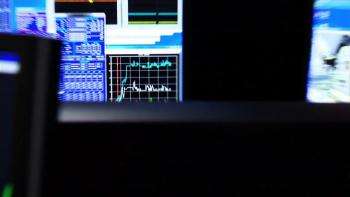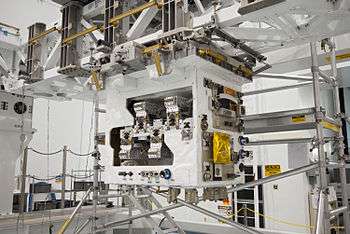Robotic Refueling Mission


The Robotic Refueling Mission (RRM) is a NASA technology demonstration mission with equipment launches in both 2011 and 2013 to increase the technological maturity of in-space rocket propellant transfer technology by testing a wide variety of potential propellant transfer hardware, of both new and existing satellite designs.
The first phase of the mission was successfully completed in 2013. The second phase experiments continued in 2015.[1]
History
Development
The Robotic Refueling Mission was developed by the Satellite Servicing Capabilities Office at the Goddard Space Flight Center (GSFC).[2] It was planned to demonstrate the technology and tools to refuel satellites in orbit by robotic means.[3] After the proof of concept, the long-term goal of NASA is to transfer the technology to the commercial sector.[3]
RRM was designed with four tools, each with electronics and two cameras and lights. Additionally, it had pumps and controllers and electrical systems such as electrical valves and sensors.[4]
The RRM payload was transported to the Kennedy Space Center in early March 2011, where the GSFC team performed the final preparations for space flight.[5] Once up on the International Space Station, RRM was planned to be installed into the ELC-4. The Dextre robot was planned to be used in 2012 and 2013 during the refueling demonstration experiments.[6]
Launch
The RRM phase 1 experiment platform was launched to the International Space Station (ISS) on 8 July 2011, transported by Space Shuttle Atlantis on STS-135, the 135th and final flight mission of the American Space Shuttle program.[2][7][8]
Technology demonstration
Phase 1
NASA successfully completed the phase 1 demonstration mission in January 2013, performing a series of robotic refuelings of satellite hardware that had not been designed for refueling . An extensive series of robotically-actuated propellant transfer experiments on the exposed facility platform of the International Space Station (ISS) were completed by the RRM equipment suite and the Canadarm/Dextre robotic arm combination.[9]
The experiment suite included a number of propellant valves, nozzles and seals similar to those used on a wide variety commercial and U.S. government satellites, plus a series of four prototype tools that could be attached to the distal end of the Dextre robotic arm. Each tool was a prototype of a device that could be used by future satellite servicing missions to refuel spacecraft in orbit. RRM is the first in-space refueling demonstration using a platform of fuel valves and spacecraft plumbing representative of most existing satellites, which were not designed for refueling.[9]
Phase 2
Phase 2 of the RRM mission began in August 2013 with the launch of the phase 2 RRM hardware to the ISS aboard the Japanese H-II Transfer Vehicle 4 (HTV-4) for test operations expected to be carried out in 2014.[10]
The Phase 2 hardware complement consists of:[10]
- Two additional RRM task boards
- The RRM On-orbit Transfer Cage
- The Visual Inspection Poseable Invertebrate Robot (VIPIR)—a "borescope inspection tool that provides a set of eyes for internal satellite repair jobs." It was launched on ATV-5 and arrived at the station on August 2014 [11]
In February 2014 the ground based 'Remote Robotic Oxidizer Transfer Test' (RROxiTT) transferred nitrogen tetroxide (NTO) via a standard satellite-fueling valve at the satellite fuelling facility, Kennedy Space Center (KSC), using a robot controlled remotely from the Goddard Space Flight Centre, 800 miles (1,300 km) away in Greenbelt, Maryland.[12]
As of January 2015 no schedule is known for the phase 2 operations
See also
References
- ↑ "NASA robotic servicing demonstrations continue onboard the space station". phys.org. Retrieved 2016-03-03.
- 1 2 "Robotic Refueling Mission (RRM)". NASA. Retrieved 5 August 2011.
- 1 2 Debra Werner (2 April 2010). "NASA Plans To Refuel Mock Satellite at the Space Station". Space News. Retrieved 10 March 2011.
- ↑ Ed Cheung. "Satellite Servicing Demonstration". edcheung.com. Retrieved 10 March 2011.
- ↑ "Satellite Servicing Capabilities Office Newsroom". National Aeronautic and Space Administration. Retrieved 28 September 2016.
- ↑ "Robotic Refueling Module, Soon To Be Relocated to Permanent Space Station Position". NASA website. 16 August 2011. Retrieved 18 August 2011.
- ↑ Bergin, Chris. "NASA managers approve STS-135 mission planning for June 28, 2011 launch". NASA Space flight. Retrieved 20 August 2010.
- ↑ "Obama signs Nasa up to new future". BBC. 11 October 2010.
- 1 2 Clark, Stephen (2013-01-25). "Satellite refueling testbed completes demo in orbit". Spaceflight Now. Retrieved 2013-01-26.
- 1 2 Messier, Doug (2013-08-04). "Robotic Refueling Mission Gears Up for Phase 2". Parabolic Arc. Retrieved 2013-08-05.
- ↑ Template:NASA’s Space Station Fix-It Demo for Satellites Gets Hardware for 2.0 Update
- ↑ Morring, Frank, Jr. (February 28, 2014). "NASA Robotically Transfers Satellite Oxidizer". Aviationweek.com. Retrieved April 5, 2014.
External links
- ISS Update: Robotic Refueling Mission Payload Overview, NASA video, January 25, 2013. "it is, or it might be—only history will tell—the start of what could be a revolution or a new era of how satellites are built and flown in space"